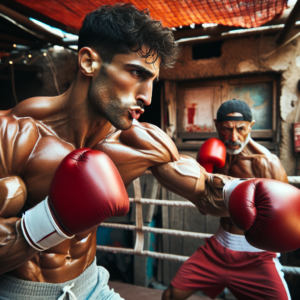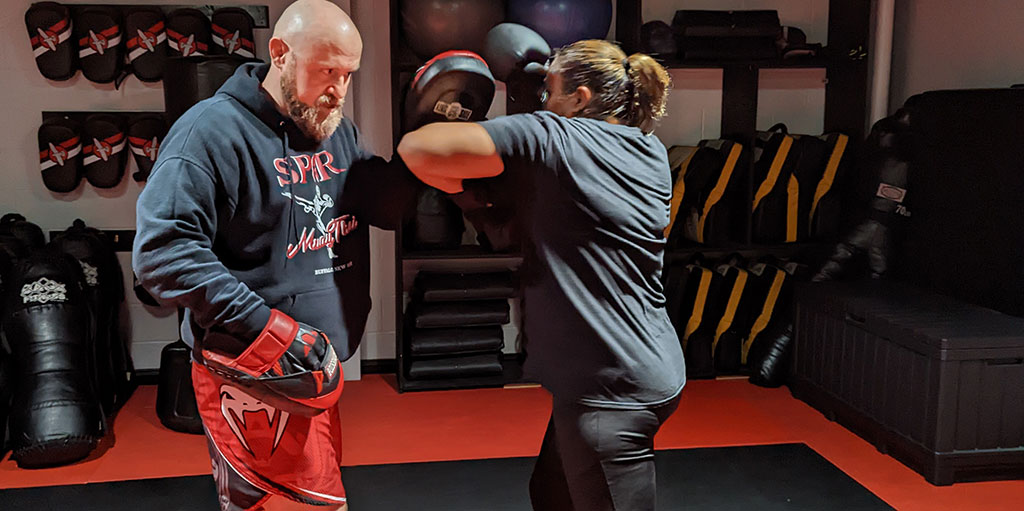
Mastering the jab: Proper technique demonstration showing the extended lead hand while maintaining defensive guard position.
1. Understanding the Jab in Muay Thai
In Muay Thai, the jab serves as a great tool in your striking arsenal.
The jab doesn’t just set up combinations or measure distance; it also controls the pace of a fight, breaking through your opponent’s defenses, while also being a powerful shot on its own.
Whether throwing it as a quick check or using it to control your opponent’s movement, the jab is a game-changer when executed correctly.
Why the Jab is Important
- Distance Control: The jab is an excellent way to establish range. By learning to control the distance, it can dictate when and how striking exchanges occur.
- Setting up Combinations: A well-placed jab opens the door for powerful punches, kicks, and can help switch you into the Clinch Range.
- Defensive Tool: A strong jab can create space when an opponent closes in or tries to smother your strikes.
- Gauge The Opponent’s Timing: Throwing a jab helps test your opponent’s reactions and defenses.

The fundamentals of a powerful Muay Thai jab: Proper stance, weight distribution, and hand positioning for maximum effectiveness
2. The Basic Mechanics of the Jab
It’s important to understand the basic mechanics of the jab.
If you’ve never thrown a jab before or are struggling with its effectiveness, make sure to focus on the following key points:
Stance
The jab is usually thrown from your lead hand (left hand for orthodox fighters, right hand for southpaws).
Your stance should be balanced with the feet shoulder-width apart and your weight distributed evenly on the balls of your feet. Make sure to keep your hands up in a guard position while keeping your chin tucked to protect yourself.
The Motion
The jab itself is a quick, straight punch that extends from your lead hand. To throw a proper jab:
- Step 1: Push off the back foot to generate power and initiate the punch.
- Step 2: Extend the lead arm straight towards your target.
- Step 3: Rotate the fist upon impact. Your palm should face the floor, and your knuckles should make contact with the target, making sure you hit with the first two knuckles.
- Step 4: Retract quickly. A key to a successful jab is the speed with which you retract the hand back to guard after hitting your opponent. The faster the punch comes back, the less vulnerable you’ll be to counterattacks.

Perfect jab execution: Note the straight lead arm, rotated fist, and protected guard position that creates both offense and defense
Body Movement
A jab isn’t just an arm punch. Proper body movement helps generate more power and speed:
- Step 1: Rotate your hips and shoulders slightly to add force, making the jab more than just a push of the arm.
- Step 2: Keep the non-punching hand glued to your chin to protect from counters.
- Step 3: Make sure you step forward into Boxing Range, aiming to get your jab past your opponent’s guard while keeping your defense intact.
Here is a Muay Thai Instructional Video Showing the Proper Way to do a Jab:
3. Key Drills to Improve Your Jab
Mastering the jab requires practice; specific drills can help refine the mechanics and build muscle memory.
Here are a few essential drills to incorporate into your training:
Shadowboxing
One of the most effective ways to practice your jab is shadowboxing.
Use shadowboxing to perfect your form and integrate the jab into a lot of your combinations.
- Focus on Technique: While shadowboxing, concentrate on proper form and mechanics. Visualize your opponent’s guard and imagine where the jab would land.
- Speed & Fluidity: The more fluid you can be with your jab, the faster it will become in real situations. Focus on speed and retracting quickly.
- Work on Angles: Move around as you jab. Practice stepping forward, backward, to the left, and to the right while maintaining the jab’s effectiveness.
Jab Against a Heavy Bag
Once you’re comfortable with shadowboxing, hit the heavy bag. This drill allows you to add power and resistance to your jab.
- Focus on Impact: Work on making solid contact with the bag, aiming to land the jab straight down the centerline of your target.
- Add Power: Use your hips to generate power while maintaining the speed of the jab.
- Combination Work: Throw the jab in combinations with other strikes, like the Cross or a Muay Thai Round kick.
Partner Drills
Working with a partner helps replicate real-life sparring scenarios.
Have your partner hold pads while you focus on accuracy, timing, and distance control.
- Pad Work: Have a training partner hold pads for you, such as Focus Gloves or Thai Pads, and practice jabbing them. Your partner should provide feedback on your form and technique.
- Partner Drills: Engage in structured drills with a partner to explore different facets of the jab. One individual can concentrate on delivering the jab effectively, while the other practices slipping, blocking, or countering the jab. These exercises enhance your distance, timing, and accuracy when using the jab.
4. Common Mistakes and How to Avoid Them
Even experienced fighters can fall into bad habits.
Recognizing these mistakes and correcting them will make a huge difference in the effectiveness of your jab.
Mistake 1: Dropping the Guard
One of the most common errors while throwing a jab is dropping the guard.
When you extend an arm, be sure to keep your opposite hand up protecting your chin and face.
The chin is the knockout button. Anytime you reach out to punch you have to minimize that exposure of the chin to your opponent.
Mistake 2: Overextending the Jab
An overextended jab leaves you open to counters.
Always aim to keep your elbow slightly bent and avoid pushing your arm too far forward. This will help maintain balance and prevent your body from leaning too far forward.
Mistake 3: Neglecting the Retract Motion
Not pulling your jab back quickly enough is a major mistake.
After throwing your jab, immediately retract your hand back to the guard position to protect from counters.
Mistake 4: Lack of Hip Rotation
If a jab is only thrown with the arm, it is often weak and slow. Incorporating hip rotation into your jab always generates more power and speed. This technique also helps you stay grounded and in control.
5. Advanced Methods to Use Your Jab
Once the basics are mastered, you can start refining your jab with more advanced techniques that will take your jab game to the next level.
Double Jab
The double jab is a great way to break through an opponent’s guard and create openings for follow-up strikes. To execute it, throw one jab, quickly retract it, and throw a second jab immediately after.
Jab to the Body
While the jab is typically aimed at the head, using it to target the body can catch your opponent off-guard. A well-placed jab to the solar plexus or stomach can disrupt your opponent’s rhythm and slow them down.
Jab Feints
A jab feint involves pretending to throw a jab, forcing the opponent to react, only for you to follow up with a different strike. This technique can help you bait your opponent into making a mistake.
Jab-Cross Combination
The classic 1-2 combination, the jab-cross combo, is a fundamental technique in all combat striking sports, including Muay Thai, Boxing, and MMA (Mixed Martial Arts).
It’s frequently utilized as a quick one-two punch to create openings for more powerful strikes.
After landing your jab, immediately throw the Cross to follow up, maximizing the impact of both punches.
6. Conclusion
Perfecting your jab in Muay Thai is a journey that requires consistent practice and dedication. Whether you’re a beginner just starting or an experienced fighter looking to improve your jab’s effectiveness, remember that the jab is one of the most versatile weapons in your arsenal.
By focusing on the mechanics, doing targeted drills, avoiding common mistakes, and incorporating advanced techniques, you’ll be well on your way to becoming a more complete Muay Thai Practitioner.
Keep training, stay disciplined, and the jab can soon become one of your strongest tools on the mat.
Here’s a highlight video showcasing GGG’s masterful use of the jab in boxing matches, demonstrating his skill and precision in the ring:

